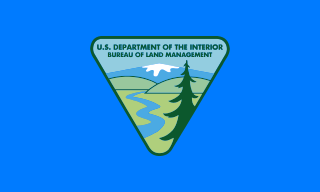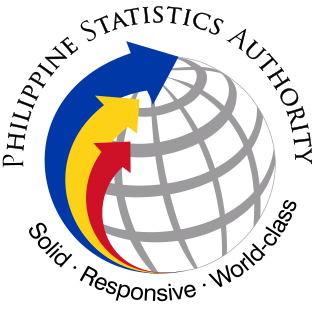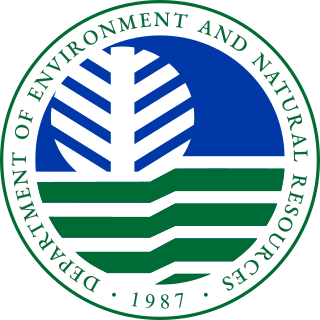
The Bureau of Land Management (BLM) is an agency within the United States Department of the Interior responsible for administering federal lands. Headquartered in Washington DC, and with oversight over 247.3 million acres (1,001,000 km2), it governs one eighth of the country's landmass.
In the United States, a territory is any extent of region under the sovereign jurisdiction of the federal government of the United States, including all waters. The United States asserts sovereign rights for exploring, exploiting, conserving, and managing its territory. This extent of territory is all the area belonging to, and under the dominion of, the United States federal government for administrative and other purposes. The United States total territory includes a subset of political divisions.
The executive departments of the Philippines are the largest component of the executive branch of the government of the Philippines. These departments comprise the largest part of the country's bureaucracy.

The Philippine Statistics Authority, abbreviated as PSA, is the central statistical authority of the Philippine government that collects, compiles, analyzes and publishes statistical information on economic, social, demographic, political affairs and general affairs of the people of the Philippines and enforces the civil registration functions in the country.

The Department of Environment and Natural Resources is the executive department of the Philippine government responsible for governing and supervising the exploration, development, utilization, and conservation of the country's natural resources.

The Department of Budget and Management is an executive body under the Office of the President of the Philippines. It is responsible for the sound and efficient use of government resources for national development and also as an instrument for the meeting of national socio-economic and political development goals.

The National Wildlife Refuge System in the United States has a long and distinguished history.
The California Department of Conservation is a department within the government of California, belonging to the California Natural Resources Agency. With a team of scientists, engineers, environmental experts, and other specialists, the Department of Conservation administers a variety of programs vital to California's public safety, environment and economy. The department's mission is to manage California's working lands. It regulates oil, natural gas and geothermal wells; studies and maps earthquakes and other geologic phenomena; maps and classifies areas containing mineral deposits; ensures reclamation of land used for mining; and administers agricultural and open-space land conservation programs. A division within the department dedicated to encouraging beverage container recycling has been moved into the newly created Department of Resources Recovery and Recycling (CalRecycle). Despite the similar name, the Department of Conservation should not be confused with the California Conservation Corps, another department within the Natural Resources Agency, which provides work experience for young adults. The Department of Conservation often collaborates with its federal equivalents, such as the U.S. Geological Survey.

The Department of Agriculture is the executive department of the Philippine government responsible for the promotion of agricultural and fisheries development and growth. It has its headquarters at Elliptical Road corner Visayas Avenue, Diliman, Quezon City.

The Philippines' Bureau of Fisheries and Aquatic Resources, is an agency of the Philippine government under the Department of Agriculture responsible for the development, improvement, law enforcement, management and conservation of the Philippines' fisheries and aquatic resources.

The Philippines' National Mapping and Resource Information Authority, abbreviated as NAMRIA, is an agency of the Philippine government under the Department of Environment and Natural Resources responsible for providing the public with mapmaking services and acting as the central mapping agency, depository, and distribution facility of natural resources data in the form of maps, charts, texts, and statistics.

Science and technology in the Philippines describes scientific and technological progress made by the Philippines and analyses related policy issues. The main agency responsible for managing science and technology (S&T) is the Department of Science and Technology (DOST). There are also sectoral councils for Forestry, Agriculture and Aquaculture, the Metal Industry, Nuclear Research, Food and Nutrition, Health, Meteorology, Volcanology and Seismology.

The Hawaii Department of Land and Natural Resources (DLNR) is a part of the Hawaii state government dedicated to managing, administering, and exercising control over public lands, water resources and streams, ocean waters, coastal areas, minerals, and other natural resources of the State of Hawaiʻi. The mission of the Hawaiʻi Department of Land and Natural Resources is to "enhance, protect, conserve and manage Hawaiʻi's unique and limited natural, cultural and historic resources held in public trust for current and future generations of the people of Hawaiʻi nei, and its visitors, in partnership with others from the public and private sectors." The organization oversees over 1.3 million acres of land, beaches, and coastal waters and 750 miles of coastal land.

The National Museum of the Philippines is an umbrella government organization that oversees a number of national museums in the Philippines including ethnographic, anthropological, archaeological, and visual arts collections. From 1973 until 2021, the National Museum served as the regulatory and enforcement agency of the government of the Philippines in the restoring and safeguarding of significant cultural properties, sites, and reservations throughout the Philippines. The mandate has since been transferred to the National Commission for Culture and the Arts.

The Ninoy Aquino Parks and Wildlife Center is a 23.85-hectare (58.9-acre) Protected Area located in Diliman, Quezon City, Philippines. It was named after Benigno "Ninoy" Aquino Jr. The Ninoy Aquino Parks & Wildlife Center has a lagoon, an aquarium, a playground, botanical garden and a Wildlife Rescue Center, which the Department of Environment and Natural Resources uses as a temporary shelter where confiscated, retrieved, donated, sick, abandoned, and injured wild animals are placed to be taken care of. The park houses several indigenous plants and animals such as crab-eating macaques, water monitors, Philippine deer, binturongs, Palawan bearded pigs and several varieties of birds.
The Comprehensive Agrarian Reform Program, more commonly known as CARP, is an agrarian reform law of the Philippines whose legal basis is the Republic Act No. 6657, otherwise known as the Comprehensive Agrarian Reform Law (CARL). It is the redistribution of private and public agricultural lands to help the beneficiaries survive as small independent farmers, regardless of the “tenurial” arrangement. Its goals are to provide landowners equality in terms of income and opportunities, empower land owner beneficiaries to have equitable land ownership, enhance agricultural production and productivity, provide employment to more agricultural workers, and put an end to conflicts regarding land ownership.

Ramón Jesús Palmiano Paje is a Filipino civil servant. He was the 19th secretary of the Department of Environment and Natural Resources (DENR) under the administration of President Benigno Aquino III. Prior to his appointment, he was DENR Undersecretary for Field Operations and Executive Director of the Minerals Development Council under the Office of the President in concurrent capacity.

The Mines and Geo-sciences Bureau (MGB) is a government agency of the Philippines under the Department of Environment and Natural Resources (DENR). The MGB is responsible for the conservation, management, development and use of the country's mineral resources, including those in reservations and public lands.

The Office of the President of the Philippines, is an administrative, advisory, and consultative government agency that aids the president of the Philippines in performing their duty as head of state and chief of the executive branch of government.
















